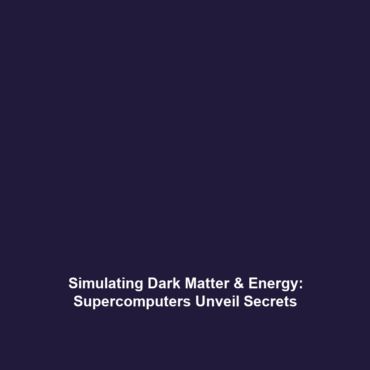Exploring Subtopics within Dark Matter & Dark Energy
The study of dark matter and dark energy is fundamental to our understanding of the universe. Within this vast field, various subtopics emerge that are crucial for deciphering the mysteries of the cosmos. These subtopics encompass key aspects of physics, cosmology, and astronomy and play a significant role in forming our comprehension of how dark matter and dark energy influence the structure and behavior of the universe. This article delves into these vital subtopics, elucidating their importance and relevance within the broader context of dark matter and dark energy.
Key Concepts
Subtopic 1: The Nature of Dark Matter
Dark matter is believed to make up approximately 27% of the universe. Understanding its presence and properties is one of the key concepts in the study of dark matter and dark energy. Research indicates that dark matter does not emit light or energy, making it invisible and detectable only through its gravitational effects.
Subtopic 2: The Role of Dark Energy
Dark energy, accounting for about 68% of the universe, is another core subtopic that warrants attention. It is responsible for the accelerating expansion of the universe. Exploring the properties of dark energy helps scientists understand the fate of the universe.
Subtopic 3: Cosmic Microwave Background Radiation
The cosmic microwave background radiation is integral to studying both dark matter and dark energy. This remnant heat from the Big Bang provides critical information about the early universe and the subsequent formation of cosmic structures.
Applications and Real-World Uses
The implications of understanding subtopics related to dark matter and dark energy extend to various real-world applications.
- How dark energy influences cosmic structures: Insights into dark energy lead to advancements in astronomical technologies and satellite missions.
- Applications in particle physics: The study of dark matter is pivotal for guiding experiments in particle accelerators.
- Astrophysical simulations: Knowledge of these concepts enhances the accuracy of simulations in cosmology.
Current Challenges
Despite the significant progress in understanding dark matter and dark energy, researchers face several challenges:
- Challenges of detection: Directly detecting dark matter particles remains elusive.
- Issues in theoretical models: Existing models of dark energy struggle to fully explain the observations.
- Limitations of technology: Advanced telescopes and instruments are required for deeper exploration.
Future Research and Innovations
As the scientific community progresses, several innovations and upcoming research avenues promise to enhance our grasp of dark matter and dark energy:
- New observational technologies: Next-gen telescopes like the James Webb Space Telescope are expected to provide unprecedented insights.
- Particle physics breakthroughs: Collaborative efforts at facilities such as CERN may yield new dark matter candidates.
- Innovative theoretical frameworks: Continued development in theoretical physics could lead to modifications in our understanding of dark energy.
Conclusion
In conclusion, the exploration of subtopics within dark matter and dark energy is essential for advancing our understanding of the universe. Each subtopic enriches our knowledge, presenting opportunities for real-world applications and further research. As we continue to uncover the intricacies of these cosmic phenomena, it is critical to support ongoing research efforts. For a deeper dive into related subjects, consider reading about cosmic background radiation, and particle physics.









